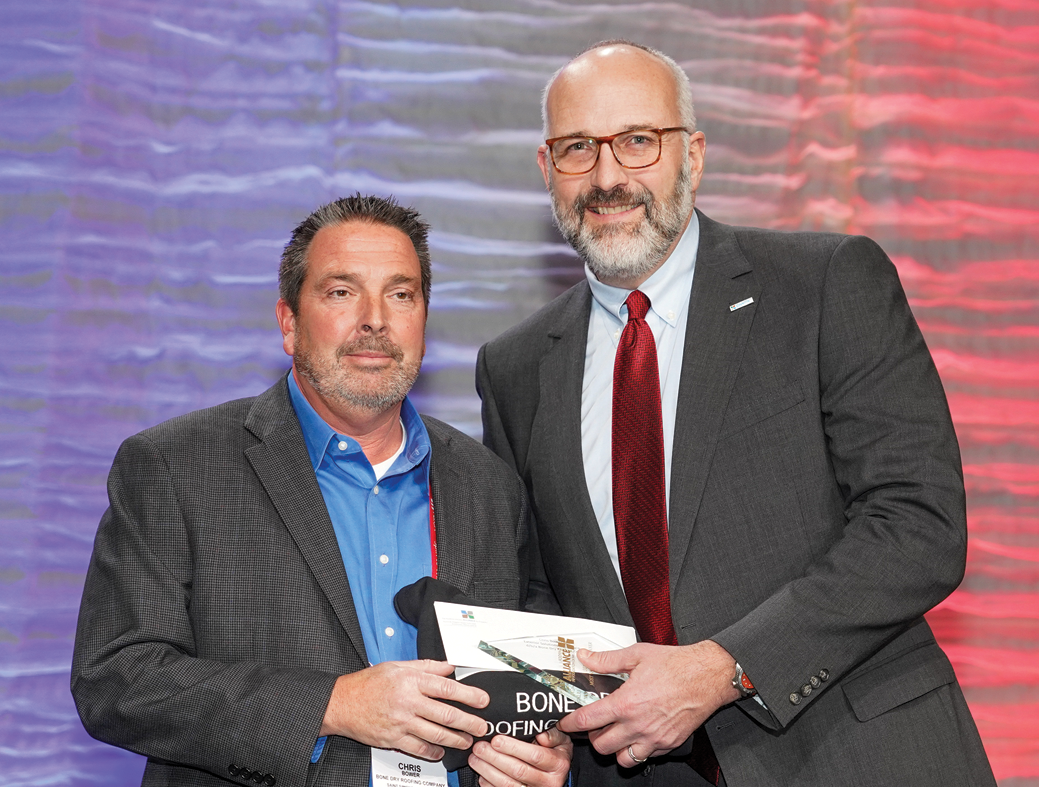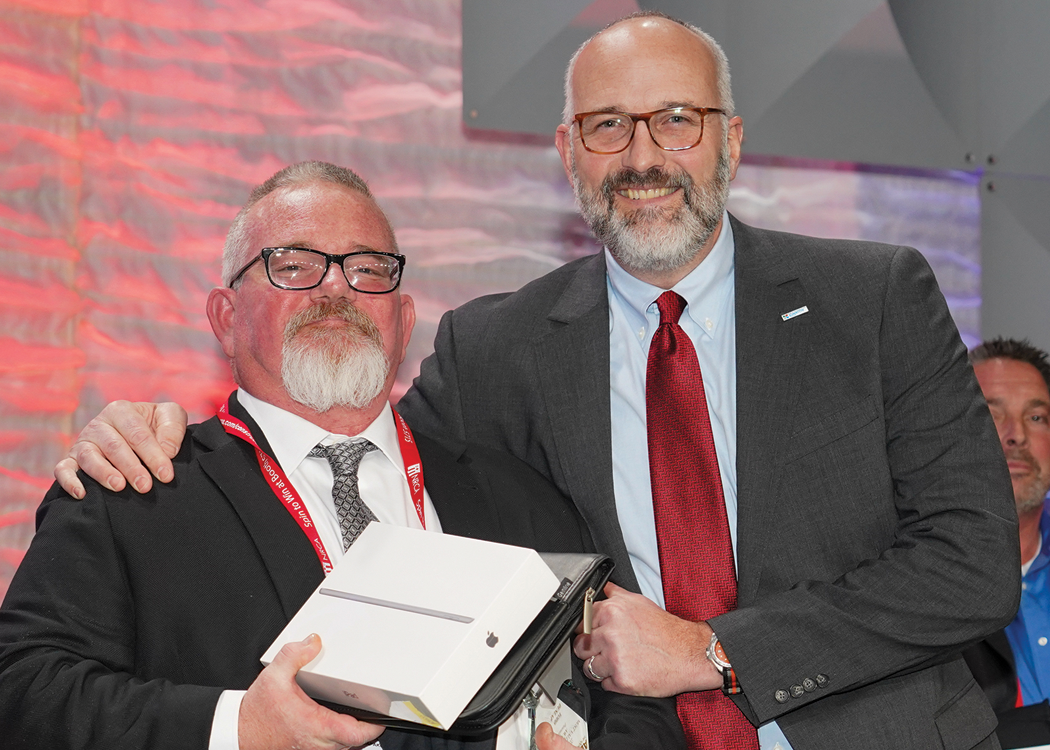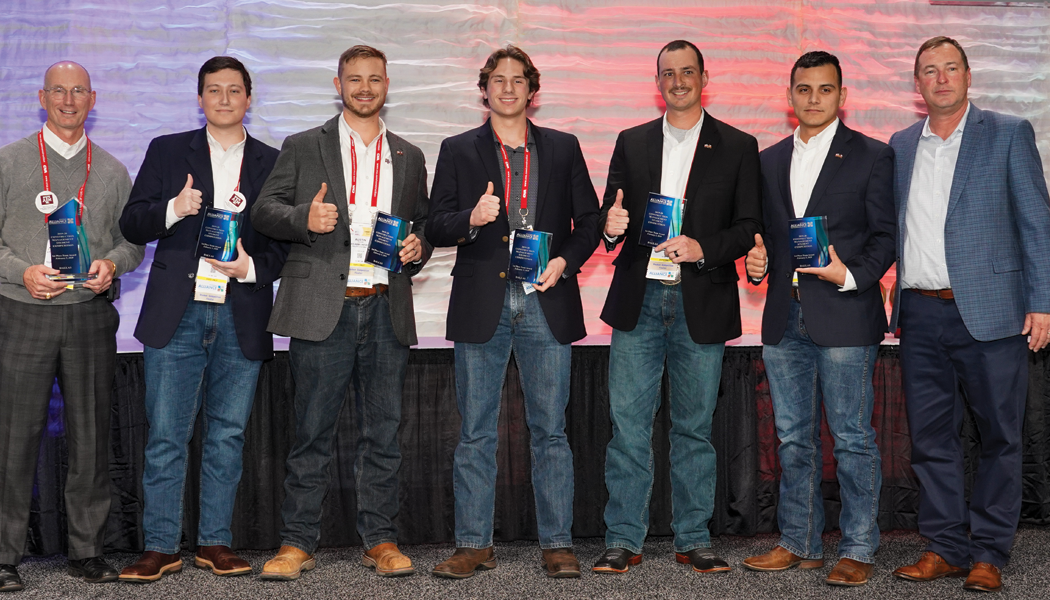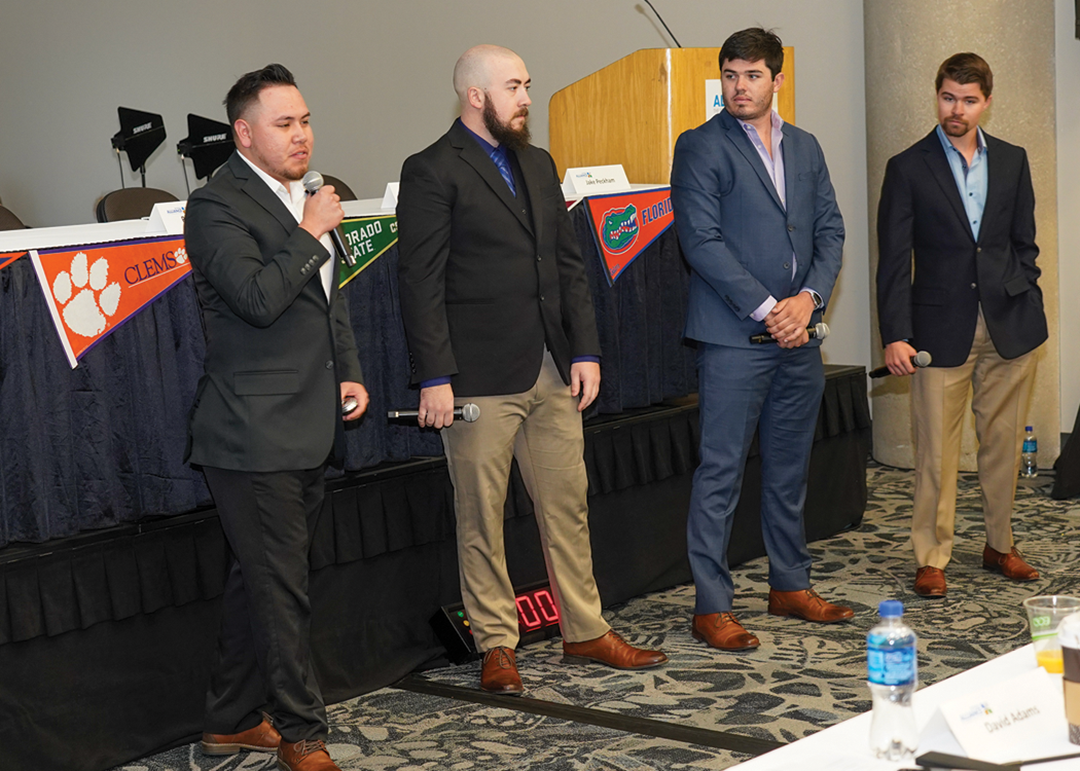Twenty-five years ago, NRCA was managing a long-established organization called the National Roofing Foundation. But the foundation had no mission statement, no strategic plan, no paid staff and little money. Fundraising consisted of friends asking friends for donations to a scholarship fund or causes that seemed important at the time. The board of trustees operated on investment income from a fund of $250,000, and because board members were reimbursed for travel expenses, there rarely was any money left for programs.
Today, that same organization has a $13 million endowment fund and underwritten numerous studies, projects and programs that have changed the way the roofing industry addresses its challenges by bringing all segments of the industry together. As the organization embarks on another 25 years, it is supporting industry efforts to manage a variety of challenges from workforce development to regulatory compliance to technical issues such as moisture in concrete, and its success is a testament to the many roofing industry professionals who have contributed not only financially but also their time and energy.
A bit of history
In 1995, the National Roofing Foundation’s board of trustees retained a consultant, Charlie Fazio, co-founder and president of Fazio International Ltd., Boca Raton, Fla., to conduct a feasibility study to see whether there was interest in building a new organization.
Fazio took a year to conduct the study, visiting dozens of contractors, manufacturers and distributors. He reported there was strong enthusiasm for creating an organization that would address common concerns. Fazio further recommended the organization be structured to operate with investment income from a permanent endowment fund, and he believed the fund could grow to $6 million during the next five years.
But to make that work, leaders from all segments of the roofing industry would need to make significant financial commitments. A minimum of $50,000 from contractors and a minimum of $100,000 from manufacturers and distributors would enable those who made significant financial commitments to become members of a reformulated foundation called The Roofing Industry Alliance for Progress; in 2018, the name was shortened to the Roofing Alliance. The board of trustees unanimously agreed to move forward with the plan Fazio presented.
Fazio also recommended enlisting the help of someone in the industry who was widely respected and admired to lead the organization’s fundraising effort. It didn’t take long to identify the perfect person, Melvin Kruger, a former NRCA president and CEO of L.E. Schwartz & Son Inc., Macon, Ga., who accepted the job.
As a first step, the organization sought support from the contractor community. NRCA’s president at the time, Bennett Hutchison III, owner of Tip Top Roofers Inc., Atlanta, convened a meeting in his office with some leading roofing contractors, resulting in a half-dozen contractors immediately committing to pledges. Soon thereafter, another group of contractors followed for a total of 20 contractors each pledging $50,000 over five years.
Fundraising then turned to the supplier community. Firestone Building Products Co. LLC, headquartered in Indianapolis at the time, and its president at the time, Paul Mineart, were recruited. To his lasting credit, Mineart embraced the idea of the Alliance and told NRCA he would recommend to his board of directors the company pledge $1 million. One week later, the foundation had a formal commitment from Firestone Building Products along with a check for $200,000. That’s when those involved with the fundraising effort knew the realigned organization was going to succeed.
The Gallup study
By the end of the first year of fundraising, the Roofing Alliance exceeded its goal with more than $6 million in pledges; the goal was $6 million. The next step was to invest $1 million on a project on behalf of those who made such commitments.
The first formal Roofing Alliance meeting was held in 1996, and major issues facing the roofing industry were identified. Interestingly, the top issue that emerged remains a top issue today—finding qualified workers. Members understood though finding workers wasn’t critically difficult at that time, it would be in the future.
The Roofing Alliance retained Gallup Inc., the same organization that conducts political polling, to conduct a study of the roofing industry’s workforce. Gallup gathered demographic information and, more important, behavioral information such as why people enter the industry, why they leave, and what they like and dislike.
The study took a year to conduct. Gallup interviewed more than 1,000 people—roofing field workers, foremen, superintendents, contractors and former roofing workers—and reported results that became the driver for the way the industry considers developing and keeping its workers.
The Gallup study revealed workers enter the industry because they like building things that matter, know they will be trained and enjoy working in teams. Through interviews, Gallup learned too often new workers were ignored or, worse, hazed and given unimportant tasks to perform. The report made it clear why the industry had turnover problems: On a new hire’s first day on the job, all the reasons he or she showed up to work were violated.
The Gallup study began a process of change in the roofing industry. For example, NRCA’s foremen training programs evolved to teaching skills such as team-building, communicating with employees and leadership. As a result of funding from the Roofing Alliance, the approach to workforce training was transformed and has continued with investments in numerous workforce-related projects, including development of Roof Application Training Programs (about 16,000 video-based programs were distributed) and, more recently, the creation of NRCA’s ProCertification® program.
Other studies
Another landmark study, The Roofing Industry in 2025, was conducted in 2005 and evaluated emerging trends to help understand what changes the roofing industry could expect during the next 20 years. Among other things, that study correctly predicted the trend toward consolidation (especially in distribution), workforce shortages, the emergence of a Hispanic workforce, and a new emphasis on energy and environmental issues.
The Roofing Alliance has funded more than $5 million in research to benefit the roofing industry. The following is a sampling:
- A study of silica in roofing to establish objective data that helps satisfy Occupational Safety and Health Administration requirements
- A study of decision-making by building owners and why they choose one roofing contractor over another (Spoiler alert: It’s not always about price.)
- An ergonomics study of roofing workers, which includes recommendations for mitigating job-site injuries
- A study to determine the life expectancy of low-slope roof systems to help change IRS depreciation rules
- Funding to support research at the Wall of Wind testing facility at Florida International University, Miami, which led to improvements in the way the industry understands how roof systems perform in high-wind conditions
- A comprehensive study of roofing industry demographics to answer questions such as: How many roofing contractors are in the U.S., and what is the percentage of Hispanic workers in the roofing industry?
- A study of moisture in concrete, enabling the industry to scientifically address issues relating to roof system failures over concrete roof decks
There are scores of other studies, but what is important is what they have in common: They all benefit the entire industry, and they never would have been done without an organization like the Roofing Alliance.
Projects and programs
In addition to research and studies, the Roofing Alliance has established a number of ongoing programs that have left a significant mark on the industry.
Early on, Roofing Alliance members decided one way to address workforce issues is to recognize the people who don’t normally get much recognition, such as workers in the field, warehouses and manufacturing plants. The Roofing Alliance’s Most Valuable Player Awards Program remains a popular awards program (see MVP Awards Program); up to 10 workers are recognized every year during NRCA’s annual convention for work ethic, leadership and involvement in their communities.
The Roofing Alliance also administers its Helping Our Own program that provides funds to people in the industry who find themselves in difficult circumstances. For example, three recipients were roofing workers who were seriously injured in the Boston Marathon terrorist bombing in 2013.
About 10 years ago, the Roofing Alliance assumed administration of the NRCA Gold Circle Awards program. The program recognizes excellence in the roofing industry for workmanship, safety and innovation. Awards are announced during NRCA’s annual convention.
About seven years ago, Roofing Alliance member Dennis Conway, principal of Commercial Roofers Inc., Las Vegas, proposed the Roofing Alliance develop a relationship with schools of construction management to attract students to the roofing industry and ensure those students have more exposure to and education about roof systems. Conway’s proposal led to a full-fledged partnership incorporating a student competition held annually during the International Roofing Expo® (see Student competition). Students are encouraged to work as interns to better understand career opportunities in the roofing industry.
And earlier this year, thanks to Roofing Alliance funding, Clemson University, Clemson, S.C., offered the first-ever roofing-specific, for-credit college class. Twenty-one students completed the class—exceeding Roofing Alliance and Clemson University expectations. Students were uniformly pleased with the class, and many expressed a deeper interest in careers in the roofing industry. At its April 2020 meeting, the Roofing Alliance authorized funding for two additional roofing-specific classes at Clemson University, which will result in nine hours of course work leading to a Certificate in Roofing. All three courses will be developed in an online format and made available at no charge to other schools of construction management throughout the U.S.
Since its days as the National Roofing Foundation, the Roofing Alliance also has had an interest in providing scholarships to family members of people working in the roofing industry, as well as young people interested in working in the construction industry. About 10 years ago, Roofing Alliance members, led by Hap Esbenshade, chairman and CEO of The Mountain Co., Parkersburg, W.Va., decided there was a need for the Roofing Alliance to have a separate scholarship fund so there always would be a source of funds available only for scholarships. Accordingly, the perfectly named Melvin Kruger Endowed Scholarship Fund was established. The fund now annually awards up to 11 scholarships of $5,000 each.
RMHC
In 2015, when I was NRCA’s CEO, I received a phone call from Roofing Alliance member Charles Antis, founder and CEO of Antis Roofing & Waterproofing LLC, Irvine, Calif. Antis had been doing roofing work—at his own expense—for Ronald McDonald House Charities® of Southern California. RMHC provides a place for families with sick children to rest near a hospital. Antis said it was such a worthwhile experience for him and his company, the Roofing Alliance should embrace the cause and develop a national partnership with RMHC.However, turning the idea into something tangible was a daunting task: There are 165 free-standing Ronald McDonald Houses® in the U.S. The Roofing Alliance immediately saw the value in a partnership agreement that would encourage Roofing Alliance and NRCA members to maintain the roof systems on those houses and got to work.
In about one year, the roofs of all 165 houses were “adopted” by roofing contractors who committed to conducting initial inspections, providing annual maintenance, taking care of minor repairs and working with the houses when they need new roof systems.
Supplier partners also stepped up. EagleView,™ Bellevue, Wash., made its roof reports of all the Ronald McDonald Houses available to the adopting contractors. And Dataforma Inc., York, Pa., developed a database to enable tracking of the work performed on each house.
Several manufacturers and distributors also have donated materials, led by GAF,® Parsippany, N.J., which now has donated materials for seven new Ronald McDonald House roof systems. In just over three years, the industry has donated more than $1 million worth of labor and materials to Ronald McDonald Houses throughout the U.S., enabling the houses to keep the families they serve together and dry.
If you visit the RMHC website, rmhc.org, you will find the Roofing Alliance’s name alongside other national partners such as The Coca-Cola® Company, AbbVie Inc., La-Z-Boy® and Southwest Airlines.®
Cheers to another 25
The Roofing Alliance’s remarkable story is one of an industry coming together for a greater cause—when all segments of the industry work together, it achieves amazing things.
It’s also a story of uncommon leadership—from the original board of trustees who envisioned a new organization to Kruger leading the initial fundraising efforts to Roofing Alliance members such as Conway who saw the need for partnering with construction management schools, Esbenshade who saw the value in a lasting scholarship program and Antis who came up with the idea of partnering with RMHC chapters.
And happily, it’s a story without an ending.
Bill Good, Seabrook Island, S.C., is a senior adviser to the Roofing Alliance and NRCA’s former CEO.
MVP Awards Program

Chris Bowers, superintendent of Bone Dry Roofing Co., Bogart, Ga., receives an MVP Award from 2019-20 Roofing Alliance President Josh Kelly, president of OMG Roofing Products, Agawam, Mass.

Best of the Best winner Todd Dunlap, warehouse foreman at Frost Roofing Inc., Wapakoneta, Ohio, receives his award from Roofing Alliance President Josh Kelly.
The Roofing Alliance’s Most Valuable Player Awards program recognizes workers who make outstanding contributions to their companies, co-workers and communities.
The award categories include:
- Outstanding On-the-Job Performance/Workmanship
- Outstanding Performance/Other Noteworthy Contributions Outside the Workplace
MVPs are role models who demonstrate work-related and personal goals to which others aspire. Roofing professionals are encouraged to nominate employees for an MVP award to recognize their outstanding contributions through on-the-job performance and workmanship and for outstanding performance and other noteworthy contributions outside the workplace. In addition, one MVP winner is chosen to be the Best of the Best, a special honor co-sponsored by Professional Roofing and OMG® Roofing Products Inc., Agawam, Mass. The person selected as the Best of the Best typically stands out in both categories.
Get involved and give back
Member participation is vital within the Roofing Alliance, and much of the organization’s strength comes from its broad base of supportive contributors. The roofing industry has a history of generosity, and for roofing professionals who would like to be involved with giving back to the industry that has given so much to them, the Roofing Alliance provides the perfect opportunity to do so.
The Roofing Alliance offers different levels of membership to encourage small-, medium- and large-sized firms to join and have a voice in determining the roofing industry’s future. Roofing Alliance leadership includes roofing contractors, roofing material and equipment manufacturers, distributors and service providers. Commitments can be pledged over three- to five-year periods. Public recognition is given in accordance with donors’ wishes and levels of commitment and include national public acknowledgement at NRCA’s annual convention and other special events and programs. Roofing Alliance members are invited to participate in project task forces established to guide the Roofing Alliance’s agenda and are invited to semi-annual meetings of the full Roofing Alliance.
The Roofing Alliance also provides roofing professionals the opportunity to fulfill their philanthropic goals through a variety of planned giving opportunities, including bequests, gifts of real estate or appreciate stock, life insurance policies, and retirement plan assets and charitable trusts.
For more information about how you can get involved, contact Bennett Judson, executive director of the Roofing Alliance, at (800) 363-9545, ext. 7513 or bjudson@roofingalliance.net, or visit roofingalliance.net.
Student competition

The team from Texas A&M University, College Station, Texas, was selected as the winner of the sixth Roofing Alliance Construction Management Student Competition.

The team from Colorado State University, Fort Collins, makes its presentation during the 2020 International Roofing Expo.
The Roofing Alliance’s construction management schools initiative began in 2013 when the Roofing Alliance partnered with McWhorter School of Building Science at Auburn University, Auburn, Ala.; the Department of Construction Management at Colorado State University, Fort Collins; and M.E. Rinker Sr. School of Building Construction at the University of Florida, Gainesville.
The initiative’s long-term goal is to expose construction management students and faculty to the roofing industry by enhancing their overall roofing knowledge, connecting them with Roofing Alliance and NRCA members in their areas and encouraging construction management students to consider the roofing industry as a viable career option.
One way to reach students is through the annual Roofing Alliance Construction Management Student Competition, a hallmark competition that promotes careers in roofing industry management. In addition to providing a significant learning opportunity, the competition fosters an environment that brings out the best in each team, encourages dialogue among the students and promotes team spirit as students rise to meet the challenge.
The competition features teams of four college and university students testing their roofing knowledge and skills in project management, estimating, safety, quality control and presentations. Written proposals are prepared and submitted by all teams. Judges review and select a maximum of five finalist teams that receive expense-paid trips to the International Roofing Expo® where they give their oral presentations, the final component.


